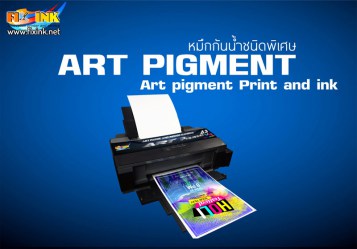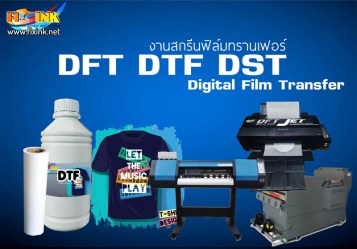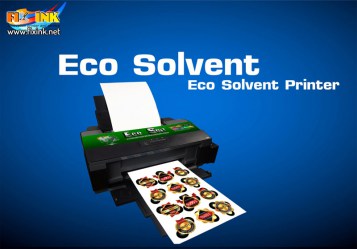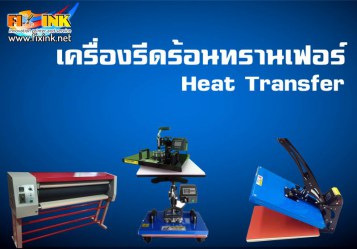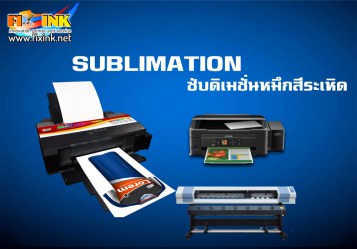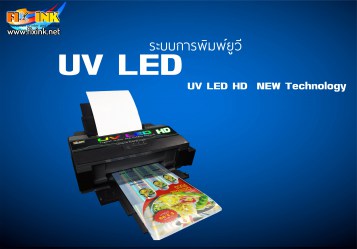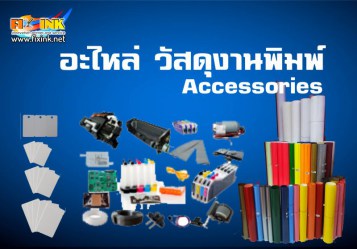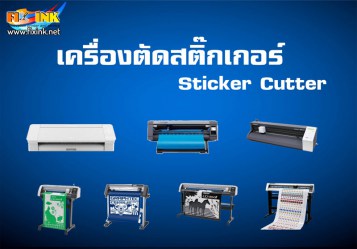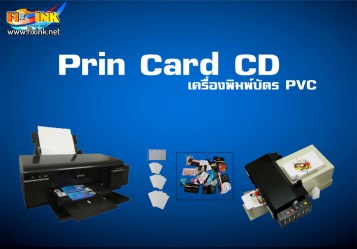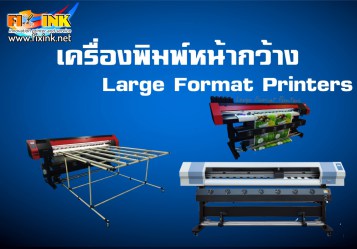หมึกพิมพ์สีระเหิด (Sublimation Ink หรือ Durasud )
ส่วนประกอบสำคัญที่สุดของหมึกพิมพ์สีระเหิดนั้น คือ แม่สีสีระเหิด (sublimation dyes) ที่ใช้เพื่อให้เกิดสีต่างๆ เมื่อได้รับความร้อน แม่สีเหล่านี้จะระเหย กลายเป็นไอและผ่านไปเกาะติดลงบนผ้าในลักษณะย้อมเส้นใยเป็นผลให้ลวดลายที่พิมพ์เกิดลงบนผืนผ้าและมีความนุ่มเช่นเดียวกับวัสดุ ในขณะเดียวกันก็มีคุณสมบัติทนต่อการซักและทนแดดได้เป็นอย่างดี
ลักษณะเด่นอีกประการหนึ่งคือ นอกจากการรีดลอกลงบนผ้าแล้วยังสามารถลอกบนวัสดุสังเคราะห์และวัสดุเคลือบผิวด้วยสารสังเคราะห์อื่นๆ ได้ เช่น พลาสติกทนความร้อน โลหะเคลือบผิว ไม้เคลือบผิว ฯลฯ
การพิมพ์รูปลอกสีระเหิด
การพิมพ์รูปลอกประเภทนี้สามารถพิมพ์ได้หลายระบบ เนื่องจากแม่สีที่ใช้สามารถนำมาผลิตเป็นหมึกพิมพ์ต่างชนิดได้ เช่นหมึกพิมพ์ออฟเซต (offset) หมึกพิมพ์กราวัวร์ (rotogravure) หมึกพิมพ์สกรีน (screen) และล่าสุดคือ หมึกพิมพ์อิงค์เจต (inkjet) ซึ่งปริมาณงานพิมพ์ ความคมชัดและความละเอียดของลวดลายที่จะพิมพ์จำเป็นต้องกำหนดระบบการพิมพ์ที่จะนำมาใช้ดังเช่น งานพิมพ์ทั่วๆ ไป เช่น ระบบกราเวียร์จะเหมาะกับลวดลายที่ต้องการพิมพ์ต่อเนื่อง (step – repeat continuous) เช่น การพิมพ์ผ้าม้วน ระบบออฟเซต จะเหมาะกับการพิมพ์จำนวนมาก และต้องการความละเอียดสูง การพิมพ์สกรีนเหมาะกับจำนวนพิมพ์ปานกลาง ความละเอียดปานกลางถึงสูง การพิมพ์อิงค์เจตจะเหมาะกับการพิมพ์จำนวนน้อย หรือใช้พิมพ์งานตัวอย่าง
การรีดลอก
การรีดลอกสีระเหิดนั้นขึ้นอยู่กับ อุณหภูมิ แรงกด และเวลา ดังนั้น เครื่องรีดลอกนี้จะนำมาใช้ในการรีดลอกนี้จะต้องมีคุณสมบัติทั้ง 3 ประการ โดยทั่วไปแบ่งออกเป็น 2 ลักษณะ คือ แบบเรียบ (flat-bed) และแบบม้วน (rotary) เครื่องแบบเรียบ จะเหมาะกับงานที่เป็นผ้าชิ้น ตั้งแต่ขนาดเล็กถึงขนาดใหญ่ สำหรับเครื่องแบบม้วน จะเหมาะกับการรีดทั้งที่เป็นม้วน เช่น ผ้าหลา และงานรีดแบบแผ่น ข้อดีประการหนึ่งของการรีดลักษณะนี้ คือความสม่ำเสมอของความร้อนตลอดแนวรีดจะดีกว่าแบบแผ่นเรียบ
อุณหภูมิที่ใช้รีดลอกจะอยู่ระหว่าง 190 – 210 องศาเซลเซียส เป็นเวลา 30 – 45 วินาที ขึ้นอยู่กับเฉดสีและชนิดของผ้า แรงกดจะอยู่ที่ประมาณ 35 – 45 psi หรือแรงกดปานกลาง
การพิมพ์
ไม่ว่าจะพิมพ์ด้วยระบบใดก็ตาม สิ่งหนึ่งที่ผู้พิมพ์จะต้องพึงระวังอยู่เสมอคือ การยืดและหดตัวของกระดาษ เนื่องจากประเทศไทยเรามีอากาศร้อนชื้นตลอดทั้งปี ดังนั้นหากต้องการพิมพ์สอดสีหรือมีเม็ดสกรีนละเอียด ผู้พิมพ์จะต้องใช้กระดาษที่มีความยืดและหดตัวน้อย เพื่อง่ายต่อการทำงาน โดยเฉพาะหมึกพิมพ์สีระเหิดที่เป็นฐานน้ำ (water-based) นอกจากนี้กระดาษที่นำมาใช้พิมพ์รูปลอก ยังต้องมีคุณสมบัติที่ไม่ซึมซับหมึกมากจนเกินไป และเมื่อรีดลอกแล้วยังต้องมีคุณสมบัติที่จะต้องให้หมึกระเหยออกไปสู่ชิ้นงานผ้ามากที่สุดโดยทั่วไปกระดาษที่นำมาใช้
กับการรีดลอกสีระเหิดนี้จะเป็นกระดาษที่มี clay coated paper โดยมีน้ำหนักระหว่าง 75 – 100 กรัม/ตรม. ขึ้นอยู่กับระบบการพิมพ์โดยเฉพาะการพิมพ์อิงค์เจต ซึ่งแนะนำให้ใช้กระดาษสำหรับการพิมพ์อิงค์เจตโดยเฉพาะ
การควบคุมคุณภาพและตัวแปรในการพิมพ์
อุณหภูมิ
อุณหภูมิที่ใช้ในการรีดลอกจะอยู่ระหว่าง 190-210 องศาเซลเซียส บนเนื้อผ้าหากอุณหภูมิในการรีดลอกต่ำกว่าที่กำหนดจะทำให้สีไม่สดหรืออาจซีดจางกว่าปกติ หรือต้องใช้ระยะเวลาในการรีดนานเกินไป และการเกาะติดของสีอาจไม่ดีเมื่อนำไปซัก หากอุณหภูมิในการรีดสูงเกินอาจทำความเสียหายต่อผ้าที่นำมารีดลอกได้ เช่น ผ้าหด ผ้าเสียรูปทรง และในขณะเดียวกันก็เป็นการสิ้นเปลืองพลังงานอีกด้วย
วัสดุ
วัสดุที่จะนำมารีดลอกนั้นจะต้องสามารถทนต่ออุณหภูมิที่จะทำการรีดลอกได้ดีโดยไม่เสียรูปทรง หรือ คุณสมบัติอื่นๆ ของวัสดุนั้นๆ และโดยทั่วไป ขนาดของวัสดุที่จะนำมารีดลอกนั้นจะมีขนาดเล็กกว่าขนาดของลายพิมพ์ เพื่อหลีกเลี่ยงรอยกดที่เกิดขึ้นจากขอบกระดาษที่ถูกกดลงไปบบตัวผ้า
เวลา
เวลาในการรีดลอกจะอยู่ที่ประมาณ 30–40 วินาที ขึ้นอยู่กับคุณสมบัติในการรับสีของวัสดุนั้นๆ ดังนั้น ผู้พิมพ์ควรทดสอบการรีดโดยใช้เวลาที่แตกต่างกันออกไปเพื่อจะได้ทราบถึงเวลาในการรีดที่ถูกต้อง โดยสังเกตจากความเข้มของสีทั้งบนวัสดุและลายที่พิมพ์ หากใช้เวลาในการรีดน้อยเกินไป ส่วนใหญ่เมื่อรีดแล้วสีจะไม่ชัด และมักมีสีอ่อนกว่าที่กำหนดและในทางตรงกันข้ามหากใช้เวลาในการรีดมากเกินไป อาจทำให้สีของวัสดุเปลี่ยนไปโดยที่สีของลายพิมพ์ไม่ได้เปลี่ยนแปลงเท่าใดนัก ในขณะเดียวกันก็เป็นการสิ้นเปลืองพลังงานและเวลาในการผลิตอีกด้วย
แรงกด
แรงกดนั้นมีส่วนสำคัญต่อคุณภาพของงานที่จะเกิดขึ้น แรงกดปกติที่ใช้ในการรีดลอกจะอยู่ที่ 35-40 psi หรือแรงกดปานกลาง หากแรงกดน้อยเกินไปก็จะทำให้เกิดการพุ้งกระจายของสี เป็นเงาจางๆ บริเวณรอบลายที่พิมพ์และทำให้ลายไม่คมชัด และอาจส่งผลต่อการเกาะติดอีกด้วย
ข้อควรระวัง หากใช้แรงกดมากเกินไปอาจทำให้วัสดุเสียหายได้ เช่น ความนุ่มฟูของวัสดุอาจลดลง หรืออาจเกิดริ้วรอยต่างๆ ที่เกิดจากการกดทับของเตารีดขึ้น
ลายผีหลอก (ghost image)
ลายผีหลอกหรือการเกิดเงาซ้อนบนชิ้นงาน อาจเกิดจากสาเหตุหลัก 2 ประการคือ การเคลื่อนตัวของแผ่นรูปลอกในขณะที่กำลังยกเตาขึ้นโดยสังเกตได้จากเงาซ้อนที่เกิดขึ้นจะเคลื่อนตัวไปในทางเดียวกันทั้งผืน ผู้พิมพ์อาจแก้ไขได้โดยการใช้กระดาษที่มีน้ำหนักมากขึ้นหรือใช้กาวสเปรย์พ่นลงบนแท่นรีดก่อน อีกสาเหตุหนึ่งคือ วัสดุที่นำมารีดลอกมีความหนาแน่นน้อยเกินไป ทำให้สีระเหิดพุ้งกระจายเข้าไปในโพรงอากาศหรือรูพรุนของวัสดุนั้น ๆ ทำให้เกิดรอยสีขึ้น ในกรณีนี้ผู้พิมพ์ควรปรึกษากับลูกค้าว่าสามารถยอมรับได้หรือไม่
สีของลวดลายพิมพ์ไม่สม่ำเสมอ
หากปรากฏว่าหลังจากรีดลอกแล้ว เฉดสีในบางพื้นที่ของลวดลายมีความเข้มอ่อนต่างกันอย่างเห็นได้ชัดนั้น อาจเกิดจากสาเหตุหลายประการ ได้แก่ ความผิดพลาดในขณะพิมพ์สีบนรูปลอกไม่สม่ำเสมอตลอดทั้งแผ่น อุณหภูมิบนหน้าเตารีดไม่เท่ากันซึ่งอาจเกิดจากลวดความร้อนเสียหายบางจุด ปัญหานี้มักพบในเครื่องรีดแบบเรียบมากกว่าแบบม้วน และสาเหตุสุดท้ายอาจเกิดจากแผ่นรีดของเตารีดไม่เรียบ มีความสูงต่ำไม่เท่ากัน ทำให้แรงกดในแต่ละจุดไม่เท่ากัน ส่งผลให้สีที่พิมพ์ไม่สม่ำเสมอ
Dye Sublimation Ink (Sublimation Ink or Durasud)
The most important ingredient in dye-sublimation inks is sublimation dyes that are used to produce different colors. When heated These primary colors will evaporate. It vaporizes and passes onto the fabric in a dyed manner, resulting in the printed pattern on the fabric and is just as soft as the material. At the same time, it has excellent wash resistance and sun resistance properties.
Another distinctive feature is Besides being ironed onto fabrics, it can also be peeled on synthetic materials and other synthetic coatings such as heat-resistant plastics. Metal veneer, wood veneer, etc.
Dye sublimation decal printing
This type of decal printing can be printed on multiple systems. Because the primary colors used can be used to produce different types of ink. E.g. offset printing ink, gravure ink (rotogravure) screen printing ink (screen) and the latest inkjet ink (inkjet), which print volume. The sharpness and resolution of the printed pattern need to determine the printing system to be used. Typical printing jobs such as gravure systems are suitable for patterns that require step-repeat continuous printing, such as roll fabric printing, offset systems are suitable for large-scale printing. And need high resolution Screen printing is suitable for medium print quantity. Medium to high resolution Inkjet printing is suitable for printing small amounts. Or use to print samples
Extrusion
Dye-sublimation extruding depends on temperature, pressure and time, therefore, to be used in this co-extrusion, it has to have all 3 properties, generally divided into 2 types: flat-bed And roll (rotary), uniform, smooth Will be suitable for work that is a piece of cloth From small to large For uniform rolls It is suitable for rolling in both rolls such as yard fabrics and sheet ironing. One of the advantages of this type of extrusion. Is that the uniformity of the heat throughout the rolled line is better than the flat sheet
Ironing temperature is between 190 - 210 degrees Celsius for 30 - 45 seconds, depending on the color and type of fabric. Pressure is approximately 35 - 45 psi, or medium pressure.
Printing
No matter what system you type One thing that publishers must always be aware of is Paper stretching and shrinking Because Thailand, we have hot and humid all year round. Therefore, if you want to print with color or have a fine screen grain The printer must use paper that has less stretch and shrinkage. So easy to work Especially the water base dye sublimation ink (Water-based) In addition, the paper used to print decal. It must also have properties that do not absorb too much ink. And when ironed, it must also have the properties that require the ink to evaporate to the fabric workpiece as much as possible.
With extrusion, this dye-sublimation paper is clay coated paper weighing between 75 - 100g / sqm. Depending on the printing system, especially for inkjet printing. Which recommends using paper especially for inkjet printing
Quality control and printing parameters
temperature
Ironing temperature is between 190-210 ° C on the fabric, if the ironing temperature is lower than the set temperature, the color will not stay fresh or may fade than normal. Or it takes too long to iron And color adhesion may not be good when washing If the ironing temperature is too high, it may damage the ironed fabric, such as shrinking, deformed fabrics. And at the same time it is a waste of energy as well
material
The material to be stripped must be able to withstand the temperature at which it will be stripped well without deforming or other properties. Of that material and generally the size of the material to be ironed is smaller than the size of the print. To avoid press marks that arise from the edge of the paper being pressed on the fabric.
time
Ironing time is approximately 30–40 seconds depending on the material's color pick-up properties, so the printer should test ironing at different times to determine the ironing time. That is correct By observing the intensity of the colors on both the material and the printed pattern If it takes too little time to iron Most of the time, when ironed, the color will be blurry. They are usually lighter in color and, on the contrary, if the ironing time is spent too much. May cause the color of the material to change without much change in the printing color. At the same time, it is a waste of energy and production time.
Pressure
Pressure plays an important role in the quality of the work being performed. Typical extrusion pressure is 35-40 psi or medium pressure. If the pressure is too low, it will cause a faint scattering of color around the printed pattern and the pattern will not be sharp. And may affect the adhesion as well
CAUTION: Excessive pressure may damage the material, for example, its softness may decrease. Or may cause various wrinkles Caused by the pressure of the iron.
Ghost image
Haunted pattern or the occurrence of shadows overlaid on work This could be due to two main reasons: the movement of the decal while the stove is being raised, which can be observed from the resulting overlapping shadows moving in the same direction. The printmaker may fix this by using heavier paper or spray adhesive on the platen first. Another reason is The material to be stripped is too dense. This causes the dye to sublimate and spread into the air cavity or pores of the material, resulting in a color mark. In this case, the publisher should consult with the customer whether they can accept it or not.
The color of the printed pattern is uneven.
If it appears that after ironing and peeling The hues in some areas of the pattern have a clear difference in intensity. This can be due to a number of reasons, including printing errors, uneven colors on the decal, throughout the sheet. The temperature on the soleplate is not the same, which may be caused by some damage of the heating wire. This problem is more common in flat presses than in rolls.




